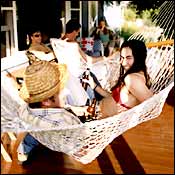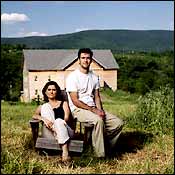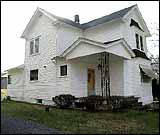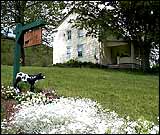
Bovina, New York, has never had a drugstore, let alone a dry cleaner. Its only restaurant closed last summer. But this summer, Bovina has buzz. Around town—hell, around all of Delaware County—phones are ringing with the news: Brad and Jennifer are buying 300 acres, the old Carter farm! They’ve got every contractor in the area onboard. And then: When they actually get here, will they want to hang out with us?
Until recently, the Catskills were best known for crumbling resort hotels and a series of local ski hills—Hunter, Windham, and Belleayre—that draw busloads of day-trippers during the winter. But these days, as FOR SALE signs dot every other rambling dairy farm, big new houses crop up on newly cleared mountaintops, and Two Old Tarts does a brisk trade in almond croissants at the farmer’s market, it’s become clear that these sleepy, charmingly shabby environs are being rediscovered. Yes, by people like the Aniston-Pitts, but also by people like you, tired of summer shares and East End beach traffic, and itching to actually own a weekend house.
Take Jared Paul Stern. On a rainy summer Friday, the Post’s “Nightcrawler” is not working the phones or trying to figure out what he’s wearing to the evening’s shindig at Soho House. As is his new norm, Stern is at home in Greene County, where his girlfriend, Ruth Gutman, is teaching him the joys of making brownies from a box. Though “we can’t do plumbing,” says Stern, in the year since they closed on their three-bedroom cottage they’ve learned to do just about everything else. They’ve built bookcases, upholstered furniture, rewired vintage chandeliers, and painted the dining room to match an orange Hermès shopping bag. Around the house, there are photographs of the years the couple spent renting, testing the waters from the South Shore of Long Island to New Canaan, Connecticut. “We loved Bellport,” says Ruth. “But it was too expensive.”
They finally bought in Oak Hill, paying about $200,000 for four acres and a 2,500-square-foot fixer-upper. It’s a place where the most exciting group to join is the 12 Tribes, a local hippie cult. Which is not to say there’s nothing to do here: Stern has been known to head into town to pick up vintage postcards or take in some donkey basketball. “It’s the Catskills version of Bridgehampton Polo,” he says. “But a lot more entertaining—it’s not just about swilling champagne and kissing up to Jason Binn.”
It’s the old Hamptons lifestyle without the new Hamptons scene, claims this generation of homesteaders—though there’s certainly no shortage of beautiful people. Kirsty Hume and Donovan Leitch set up house in Woodstock. Uma Thurman and Ethan Hawke bought a farm by her parents in Woodstock. Robert De Niro is here, as are Yoko Ono and The Sopranos’ Steve Buscemi and Edie Falco. Kelsey Grammer lives in Andes, and he’s just about everywhere (“He even goes to the A&P like everyone else,” says one local). Since Chandra North moved to Stone Ridge, she’s made new friends, had a baby, and learned to cross-country ski. “I like the beach as much as anyone,” she insists. “But I can’t deal with sitting in traffic for five hours.”
Even Giselle and her Yorkie have found time for sojourns in the mountains between fashion shoots and trips to Brazil. “My boyfriend was talking to her once, and she was like, ‘Now, where is your house? And how do you get there? And do you have a car?’ ” recalls Jed Root, a photographers’ agent who weekends in one of the area’s legendary homes, a twenties concrete castle on 40 acres in Palenville that he bought two years ago for about $375,000. “The next time we saw her, she was like, ‘Oh, hey, I bought a house near Woodstock and a Toyota 4Runner.’ ”
When you’ve grown accustomed to pooling funds for a $40,000 summer rental, there’s serious sticker shock in seeing a house that can be all yours with a $20,000 down payment. A three-bedroom pad on at least ten acres with a swim pond, a barn, and paddocks, 100 miles or so from the city, costs about half what you’d pay for a one-bedroom in Manhattan.
And for those jaded by celebrity-packed store openings and P. Diddy sightings, two dress-down days a week are refreshing. “The last thing I want is to go out on weekends and put on makeup,” says “Page Six” reporter Paula Froelich, who recently bought a one-bedroom cottage on four acres in Lexington for $60,000 (when friends come to visit, they stay at the $25-a-night Lexington Inn). “I bought in the Catskills because (a) it’s affordable, (b) there’s more than one fucking road that goes there, and (c) no one wears Jimmy Choos.” And this from someone who’s best friends with Lizzie Grubman.
City people coming to the Catskills is certainly nothing new. The New York State Legislature declared the mountains “forever wild” in 1894 and created the Catskill Park. Now the region is unofficially defined by county lines—anything in Sullivan, Ulster, Delaware, or Greene counts.
Buy the Farm
BY SHYAMA PATEL
Just a sample of what you can get and for how muchShore Losers
BY SARAH BERNARD
Hamptonites defend their territory and say “Good Riddance!”

There’s a country setting here for practically everyone: densely forested mountains with panoramic views; farmland on the western fringes of the park, where parcels run to the hundreds of acres; bustling historic towns on the banks of the Hudson. While you may not be able to plunge into the ocean before breakfast, you can rock-climb in the Shawangunks, hike up Kaaterskill Falls, bike around the massive reservoirs, or take a dip in your very own spring-fed pond. You can also just sit on your deck with a gin-and-tonic, gazing out at the horizon. As for the bugs, don’t believe lowlander hype: Mayflies are gone by mid-June, and it’s generally too windy in the mountains for mosquitoes.
The best part is, there is no off-season. This is New York ski country, after all.
The Catskills became popular as a summer destination in the early nineteenth century, when New Yorkers looking for fresh air—and Hudson River School painters looking for inspiration—shlepped by boat and coach to Greene County’s first hilltop hotel, the Catskill Mountain House. Still known to many as the Borscht Belt, the area became a haven for immigrant groups in the late nineteenth century, when the Ulster & Delaware railroad line started service from Kingston through Phoenicia and into Delaware and Greene counties. As the visitors became more prosperous, the accommodations grew more lavish: The original Catskill Mountain House grew to 300 rooms, the Grand Hotel in Highmount had 418, and the last of the lot—the Hotel Kaaterskill—had a staggering 800. By the twenties, however, the hotels had fallen into disrepair, and eventually the U&D went out of business. In the post-Depression years, the Catskills became home to countless Dirty Dancing–style bungalow communities. This was the era of old-school stand-up comedians like Henny Youngman, Shecky Greene, and Milton Berle, and family vacations that lasted all summer.
Since the seventies, the region has been in a slump. There have been efforts to revive it, most notably in the eighties, when brokers were pushing the Catskills to the city’s gay community as a sort of Fire Island–in–the–mountains. While this sold a handful of ski houses, the impact on the economy was minimal. Granted, there have always been pockets of serious money in the area, most famously in the exclusive Beaverkill Valley, Laurence Rockefeller’s old trout-fishing preserve between Roscoe and the Pepacton Reservoir, which has now been parceled off to wealthy New Yorkers (Amanda Burden owns in Beaverkill; so does Dan Rather). And, of course, there’s always been money in Woodstock.
Woodstock took off in 1903, when Ralph Radcliffe Whitehead and his wife, Jane Byrd McCall, purchased a 1,500-acre area of land near the village, built a handful of humble Arts and Crafts cottages, and created the area’s first artists’ colony. Visitors included Thomas Mann, Isadora Duncan, Helen Hayes, and Bob Dylan, who lived here in the sixties. The original “Byrdcliffe” homes are now the ultimate in rich-hippie chic. Sharon Gannon and David Life, owners of Jivamukti Yoga Center, bought theirs four years ago. “Byrdcliffe is a historical monument,” explains Gannon. “Starbucks can’t come in here, McDonald’s can’t come in here. And,” she says proudly, “we have a satsang.” A satsang? “It’s a Sanskrit term: a community of like-minded people who believe that awakening is possible.”
But many would argue that Woodstock’s already had its awakening: It has gift shops, and fudge shops, and ice-cream parlors, and an organic supermarket; it has the Bear, the area’s “only decent restaurant,” as Lois Freedman, director of operations at Jean Georges, puts it (she has a house in nearby West Saugerties). Two weeks ago, David Bowie picked up a 60-acre mountaintop spread here for a cool $1.2 million—a bargain compared with East Hampton, but far more than most recent converts are willing to pay.
The current invasion kicked off in the mid-nineties, as the East End of Long Island exploded with movie stars, VIP lists, and $30 cover charges. Randy Florke, a former model with Iowa-farm-boy good looks and a fondness for fixer-uppers, set up house in Sullivan County and opened a real-estate agency in the West Village called the Rural Connection. Papered with almost absurdly cheap listings (a $13,000 shack on two acres, for instance), the agency’s windows quickly became something of a spectacle in a neighborhood where would-be renters battle over $2,000-a-month studios. Florke sold to dozens of his Manhattan neighbors, who have colonized the back roads of Jeffersonville and Livingston Manor, opening ever more cute little B&Bs and antiques shops. His average price is now $250,000.
Soon, the influx, though slow to start, was under way, beginning on the park’s southern borders, from High Falls, on the banks of the Hudson, all the way west to Roscoe, and then creeping north to tiny hamlets above the park—places with no fancy stores or restaurants to speak of, but something much more valuable: acreage.
‘We’ve done 95 percent of the work ourselves,” says Michelle Beck of the five-bedroom Roxbury farmhouse she’s decorated with a “Lucky Charms theme—blue moons, yellow diamonds … ” Michelle and her husband, George Wieser, a cinematographer, discovered the six-acre property in 1997, on a joyride in their 1969 Chevelle convertible. “We’d stop in farm towns, and just for the kick we’d have Realtors take us to houses,” she recalls. Two months after they discovered Delaware County, they closed on the house for $106,000. “For the first few years, we ran it as a mini-B&B,” says Beck. “Anyone could come up unannounced, and we’d put them to work.”
Most of the steals up here need renovating. When Jill Goldring and Aki Davis were looking, they saw plenty of places with questionable potential, from a cottage in Mount Tremper inhabited by an incontinent pot-bellied pig (the real-estate agent kept saying, “Oh, don’t worry, the smell will come out,” says Goldring, rolling her eyes) to a nineteenth-century farmhouse with an actual stream running through the basement. So when their vintage Porsche wound its way up a long wooded driveway to a wedge-shaped modernist gem overlooking the Pepacton reservoir, Goldring, an advertising executive, and Davis, a photographer, made an offer the same day. “It was completely turnkey,” she remembers. The house came equipped with everything from the Nakashima table and rare Jacobsen light fixtures in the dining area to the vintage flatware in the kitchen drawer. “The owners left us this note saying ‘The sheets are clean and the beds have been made,’ ” says Goldring. “They left the food in the pantry!” And in spite of near-total isolation (they own about 35 acres, and New York City owns practically everything around them, thanks to the watershed), they’re getting to know the neighbors. “We’re having dinner with these people we met in Kingston last summer,” Goldring says, sitting on her deck one hazy country evening. “They’re Porsche people.”
When you consider what many of these newcomers do during the week—they’re artists, journalists, fashion stylists, photographers, architects, advertising executives, and so on—it’s tempting to compare the Catskills to the bohemian pre-L.I.E. Hamptons of the sixties, when Bridgehampton and beyond drew a flock of similarly stylish young artists and writers. And the fact is, many of the hip new arrivals were once Hamptons people. “They used to take it for granted that they would end up with a house in the Hamptons,” says Carmon Deen, a broker at Ron Guichard Realty, who has sold countless homes to newly married young professionals in the past two years. “But then it becomes clear to them that they are not going to end up owning there, and this becomes a viable option.” He pauses and thinks a little longer. “To be honest,” he says slowly, “I’m beginning to wonder how there can be anyone left in Sag Harbor.”
“We spent quite a few summers on Long Island—in Bridgehampton, Shelter Island, one on the North Fork,” says Michelle Sanders, accessories director at Vogue. “Then last summer, we rented in Woodstock. It was definitely more our speed, but it still wasn’t rural enough.” Sanders and her husband, Derek, an architect with Can Resources, eventually moved farther west, landing in a barn on twelve acres just outside Roxbury, which they bought in December for about $150,000, gutted, and are renovating so extensively that they have yet to spend the night in it. Despite its raw form, the 8,000-square-foot structure is already an impressive pastiche of the new and the old, of downtown loft and backwoods barn. “It would be impossible to find something this size in Long Island,” says Michelle.
Anne Slowey, fashion-news director at Elle, doesn’t miss the Hamptons, either. Five years ago, she paid just over $200,000 for a 1926 hunting lodge called, rather appropriately, Windfall. The five-bedroom cottage is on 60 acres outside Roscoe. “When we first started going out to the beach, we’d ride our bikes everywhere and see flocks and flocks of geese flying over the cornfields,” she remembers of the twelve summers she and her husband, architect Rodger Fairey, rented in Southampton. “But then it turned into a boardwalk; it was like Brighton Beach. People were aggressive and rude. It’s like that Joni Mitchell song,” she says. “ ‘They paved Paradise.’ ”

Upstate, it takes Slowey a full hour round-trip to buy her Sunday Times, but she relishes the lack of amenities. “There’s no designer anything in this town,” she says happily. “These people carry shotguns and fishing poles.” Plus, she points out, “every farm is a boutique farm. Someone sells maple syrup, another sells fresh eggs, another has beautiful flowers.” And while there’s nowhere to be seen, there’s plenty to look at: “I have fawns who sleep in my yard and coyotes who come out to eat them.”
Living among the coyotes is not for everyone. Matthew Lee and Ted Lee, South Carolina–bred brothers who make a living writing about southern foods, prefer the more urban nature of the northeastern Catskills. Their new pad is a three-bedroom house in Coxsackie, an eighteenth-century mercantile town on the Hudson River. They bought it last spring for $140,000. “After dreaming of farmland, we realized that the country setting we most wanted wasn’t dark and quiet when the sun went down,” says Matthew. “At some point, that’ll be appealing, but now it’s more important just to have a manageable 0.2-acre plot and access to more fun: food, booze—and we’re 50 yards from the free boat ramp.”
The Catskills offer endless opportunities to plan your dream house—the Lee brothers are saving for a new slate roof, Anne Slowey is importing a load of seventeenth-century French stone for her bathroom, Jared Paul Stern wants a swimming pool sometime in the near future (though, to be fair, “not a big one”)—but there’s no arguing that they are remote. What the Catskills don’t have is a ready-made sense of community—for weekenders, at least.
In an area where local families count the histories of their friendships in generations, not years, there’s not a lot of mingling between the old and the new. Look past the euphoria that the recent economic growth has created among the contractors and the real-estate brokers, and it’s clear that for many of the people who live and work in the Catskills, the swarms of shiny European cars are about as welcome as the deluge of water that flooded dozens of towns to create the area’s reservoirs in the fifties.
Every day, between stories on the local high-school sports stars and the latest DWI offenders, the Catskill Mountain News tells of yet another territorial squabble between those who want to keep the wilderness unspoiled and those who want to profit from it: There was the fight in Andes over replacing individual septic tanks with a town sewer system (good for the watershed protection efforts, but bad for local business since a sewer’s capacity limits growth). Then there’s the puppeteer–house painter from the Green Party—a weekender favorite—winning the mayoral race in New Paltz. In Gardiner, there’s the “Save the Gunks” effort to prevent a developer from subdividing the 2,700-acre Awosting Reserve into plots for 349 luxury homes.
And then there is the mother of all conflicts: For the past four years, there’s been a dispute over the future of Highmount. Dean Gitter, owner of the $500-a-night Emerson Spa in Shandaken, followed a New Age guru to the Catskills before any of the recent arrivals and had the foresight to buy himself half a mountain, not to mention the local water supply. Now he’d like to turn his property into an 1,800-acre golf course with several more expensive lodgings. While the contractors and shop owners who would profit from the tourist traffic are all for it, weekenders who crave privacy—and locals who fear a population boom—are not. “It’ll take eight years to build,” says Peter DiModica, Shandaken town supervisor and owner of a small antiques shop in Pine Hill. “And between 600 and 900 workers. People from all over the country will be doing the work, putting pressure on housing and increasing rents for people who live here.”
It’s that fear of being priced out of the area that makes some locals suspicious of newcomers. Toni Perretta, a former cosmetics executive who now runs a popular restaurant called That Certain Something, found this out the hard way when she moved to Fleischmanns in 1996. “When I got here, I noticed that the established communities had more activities,” she remembers. “So I organized a Fleischmanns Field Day. It was designed to be cultural. We got Herb, who trains falcons and hawks; we had storytellers; I had a line caller and a square dance.” But Fleischmanns, named after the margarine family who built the stately Victorians that line Main Street, is a quiet little town that had been in decline since the forties, and her new neighbors didn’t want to play along.
“Field Day was one of the worst experiences I’ve had up here,” says Perretta. “There were rumors that this was a get-rich-quick scheme for a city girl, and no one showed up. I think that they wanted to discourage me. People who were born here, they’re concerned by, say, what’s happened in Woodstock. They’re afraid they won’t be able to afford to live here.”
On the first dry day of the summer, the weekly farmers’ market at the Round Barn in Halcottsville hums with vendors hawking everything from farm-raised lamb chops to handmade note cards, and smartly dressed weekenders pick their dinners from artfully arranged mounds of radishes, new potatoes, and tomatoes.
Dominic Michel, who works for the nonprofit educational organization Prep for Prep in Manhattan, takes a swig of fresh strawberry juice as he surveys the scene. “My family’s been coming to Roxbury for 40 years,” he says. “See that house over there? When I was a kid, my friend lived in it, and he’d have to chase the cows into the barn before he went to school. I always get a kick out of coming here because I think of Richard and those cows.”
Already, cows in the Catskills seem to be headed the way of the potato farms in Long Island—driven into extinction by rising land values. “We’ve all had to diversify,” says Barbara Hill, a former dairy farmer who’s now presiding over her family’s maple-syrup booth. “I just saw in the paper today that the 25-years-ago prices for milk were the same as they are today.” She eyes a group of venture capitalists in designer sunglasses who are checking out her $3 bags of maple sugar. “The maple prices aren’t the same—that’s for sure!”
Neither are the land values—particularly in Greene and Delaware counties, where asking prices have gone up at least 20 percent in the past year. Witness a massive, McMansion-ish hilltop spread that a contractor built for himself near Margaretville: It sold last year for about $750,000; the new owner is now trying to flip it for $1.25 million.
Widespread price inflation is making homesteaders wonder if they’re going to want to live here in twenty years—or whether the landscape will be spoiled by suburban sprawl. “Every week, I speak to another person who’s getting a house in the Catskills,” says Raina Penchansky, publicity director for Coach (she and her husband bought in Margaretville last fall). “But it’ll never be the Hamptons. There aren’t as many homes, and there’s tons of land. They’ll never be able to build like that.”
She’s got a point: Delaware, Greene, Ulster, and Sullivan counties encompass an area of 4,200 square miles; the South Fork of Long Island is about 150 (in fact, all of Long Island covers 1,700 square miles). So while you and your friends may all be moving to the boonies, learning to weed gardens and to maneuver the kind of all-wheel-drive wagons you used to think were just for soccer moms, it’s unlikely you’ll be bumping into one another when you get there.
Buy the Farm
Just a sample of what you can get and for how much

Wawarsing, Ulster County
The house: 1890s Colonial with wraparound porch. Six bedrooms. Two baths. 2,700 square feet.
The land: Seven acres. Mountain views.
Agent: Flemming Realty (845-687-4451).
Price: $300,000

Lake Huntington, Sullivan County
The house: Renovated 1920s farmhouse. Hardwood floors. Spacious living area. Three bedrooms. Two baths. 1,700 square feet.
Property: Ten acres. Barn. Fruit trees.
Agent: Malek Properties (845-794-3336).
Price: $170,000

Lexington, Greene County
The house: 1850s farmhouse. Needs work. Seven bedrooms. One bath. Minutes to Windham and Hunter. Separate guesthouse.
The land: 119 acres. Forest and fields. Barn.
Agent: Coldwell Banker (845-586-3321).
Price: $299,000
East Meredith, Delaware County
The house: 1850s Greek Revival. Three bedrooms. Two baths. Chef’s kitchen. Completely upgraded with high-end fittings.
The land: 60 acres. Total privacy. Stables.
Agent: Ron Guichard (845-676-3600).
Price: $425,000